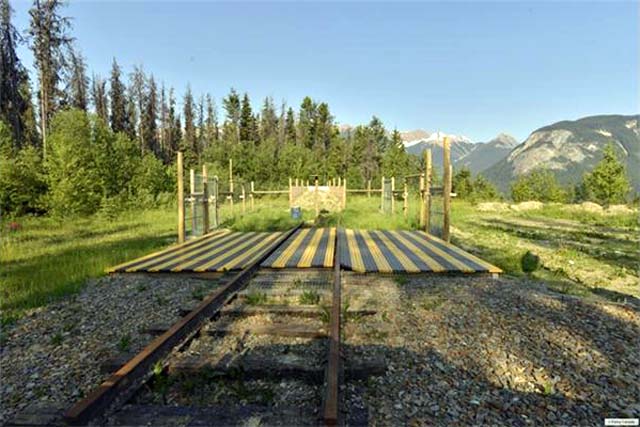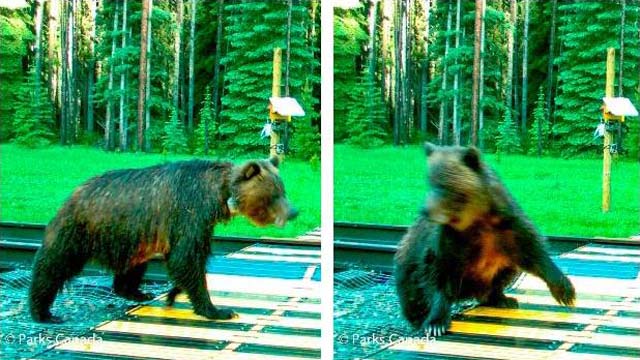|
Grizzly bear No. 130 reacts to the electromat after being drawn in by bait - 30 Oct 2013 Photographer unknown - Parks
Canada.
30 October 2013
Grizzly Bears Respond to Shock
That Could Save Their Life
Banff Alberta - A grizzly bear smells a carcass, either a beaver or an elk, walks up to the mocked-up train tracks and steps onto an
electrified mat.
Shocked, it retreats.
Not only that, the bear appears to have learned an important lesson that could save its life.
It's a scenario that has happened several times in the past year, when Parks Canada started a pilot study at two test sites built to mimic a fenced railway
line.
The so-called electromats were placed at the fence openings.
"So far, we've had four attempts by grizzly bears, three different animals.
One tried twice and, in all cases, they were repelled from the site," David Gummer, wildlife biologist with Banff National Park, said
Wednesday.
"They didn't test the mat again, but some of them did come back to the area."
"They were clearly still attracted, but unwilling to try the mat again."
"So that's a promising result."
It's one of the preliminary findings in an ongoing project between Parks Canada and Canadian Pacific that's working to prevent grizzly bear deaths on the
railway tracks.
Since 2007, the railway has become the most common threat to bears in Banff National Park, with a total of 13 grizzlies killed by trains.
Survival in the protected area is considered critical because there are only about 700 grizzly bears throughout Alberta, leading the province to declare the
species threatened.
After much scrutiny over the deaths, Canadian Pacific announced $1-million in 2010 toward a five-year project that would find solutions to the growing
problem.
Now in its third year, the rail company has made efforts to reduce the amount of grain spilling from its trains, added whistles in high-risk areas, and added
on-board camera systems to record collisions.
Parks Canada has also brought in teams of internationally recognized experts in the fields of conservation biology, animal behaviour, transportation research,
and bear biology.
Project lead Colleen Cassady St. Clair, a biological sciences professor at the University of Alberta, said it's been a valuable project.
"It's been a couple of years of tremendous growth," she said.
"By working together and digging deeper into this problem, we are revealing quite a few complexities."
For example, she said there's food sources such as buffalo berry, dandelions, and foxtails growing along the tracks, but getting rid of the plants would
degrade important bear habitat.
They've also identified some of the "hot spots" along the tracks where bears have been killed and started to look for reasons.
Although she's not certain the deaths will be eliminated, Cassady St. Clair said there will be ways to reduce the numbers.
"The electromat is one example of these really innovative solutions," she said.
"The preliminary results are mind-blowing."
Gummer said No. 122, a large male grizzly bear that made national headlines last summer after he ate a black bear, has visited both of the test
sites.
At the first one, he was shocked by the electromat.
"We have all that recorded on camera," explained Gummer.
"He lingered around the site, unwilling to cross the mat."
"Later in the year, he visited the other site and wasn't willing to test the mat there, either."
"So that's very interesting."
The electromat results are still preliminary, but considered a potential way to prevent wildlife from entering the rail line at fence ends.
"We're very encouraged by the results," said Chris Bunce, chief environmental engineer for safety, environment, and regulatory affairs with Canadian
Pacific.
"There's a lot of really strong fundamental science going on in terms of the vegetation assessments and bear habitat assessments."
"Parks Canada is working really well on identifying what areas the bears are using, both along the railway tracks and off."
Other components of the overall project, which includes both Banff and Yoho national parks, have included fitting 11 grizzly bears with GPS collars to better
monitor their movements and attaching GoPro cameras on the front of trains to record how bears react.
Colette Derworiz.
 A baited test site built for the study - 30 Oct 2013 Photographer unknown - Parks Canada.
|


